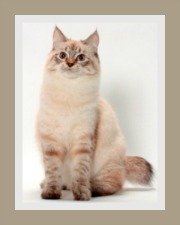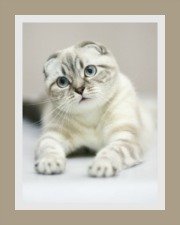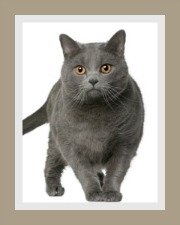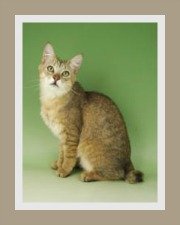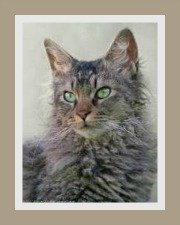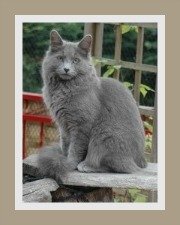Burmese Cat Breed
Facts and Breed Profile
The Burmese cat breed could be described as a 'little military tank draped in glossy satin'. This is a dominant cat that is also known as the Rajah cat.
Whilst the Burmese may have its roots in Burma, it was developed in
the USA and today this domestic cat is bred around the world.
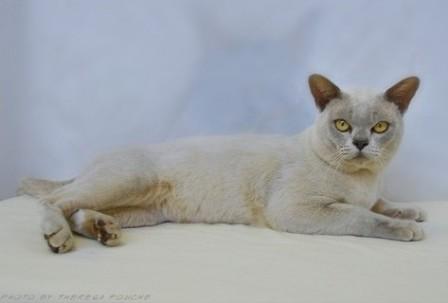
Onaoan Aurora Outback Jack | Lilac Burmese | owned by Jane Goble and Alison Renwick | bred by Valerie Cashman | photo © Theresa Fouche
It is no surprise that people passionate about the cat breed would continue to develop the breed resulting in additional colors and other physical differences.
As a reuslt of this, the Burmese has two recognized breed standards -
the American Type and British-European Type.
features and characteristics
americanThis cat has a medium-sized body, well developed, with a substantial bone and muscle structure. The general appearance of the cat is compact and strong, with a rounded chest. The cat is surprisingly heavier than its size would have you believe. |
britishThe British Burmese has a slender, less compact elegant body, somewhere between the Siamese and the British Shorthair. In other words not an elongated body or a short body. |
|
Its tail is of medium length and straight and its legs are in proportion to its body. |
Its tail is straight and medium in
length, but thick at the base and the tip of the tail is rounded.
This variety has well proportioned, slightly slender legs. |
|
American-type Burmese has a rounded, broad head. Face and cheeks are also round,
complemented by a round, short muzzle, strong jaw and a round firm
chin. They do have a visible nose break. |
In the British version, the head is triangular or wedge-shaped. Cheek bones are prominent, there is a clear nose break and the muzzle is blunt. |
|
Ears are set well apart, medium in size, broad-based with rounded tips. Eyes are round, large and set far apart. The color is yellow to gold and has a deep brilliant color. Kittens are born with blue eyes that turn gold at about 2 - 3 months. |
Ears are set well apart, medium in size, broad-based with rounded tips. Eyes have a rounded lower line and the upper line has a slant towards the nose. Eye color is the same as the American-type and kittens also have blue eyes that turn gold. |
|
The coat is short and lies close to the body. It has a lustrous satin-like feel, fine with a very distinctive glossy look. The coat should be an even-color and the underbelly is generally lighter than the back, but the shading from top to belly should have gradual shading. Kittens only
show their mature color at about 3 months. |
The
coat characteristics are the same as the American-type Burmese cat
breed. |
|
Only 4 colors are recognized in the American-type: The original Sable (which is dark brown cat), Champagne (warm honey-beige), Blue (medium blue with fawn undertone) and lastly Platinum (pale, silvery gray). Other colors are considered Dilutes which is a separate category under the Burmese Division for Dilute variants. |
The British standards accept the following colors: Brown (Sable), Blue,
Chocolate, Lilac, Red, Cream and Tortoiseshell. |
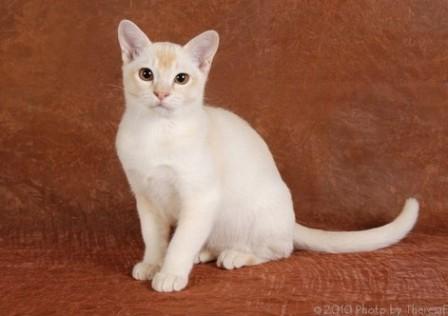
Pearl Stephanie | red Burmese | owner-breeder Penny Steyn | photo © Theresa Fouche
burmese cat information
ideal home | ideal family
The Burmese cat breed adapts well to apartment living, but like many cats, they do love the freedom of an enclosed, safe and escape-proof garden.
They prefer a home where they have companionship a great deal of the time - they do not enjoy solitude!
How well do they adapt to children? They are child-friendly cats and make wonderful companions for kids. Younger children must be taught how to handle cats. Tail and ear pulling is not considered play and most cats will react negatively to rough play.
Is the Burmese cat animal friendly? They are, but they prefer human company. They don't really appreciate the company of other cats.
burmese cat personality and temperament
We have asked many owners about the temperament of their Burmese cat.
Temperaments and personality differ from cat to cat - genetics and 'upbringing' all play a part.
It was probably for this reason that we found conflicting views.
The Burmese has been described as extrovert, demanding, energetic and exuberant.
They are intelligent, have strong personalities and can be stubborn. They are fearless and brave.
Burmese cats can be dominant cats who like to express this 'power' with other cats, but then again, some thrive on the companionship of other cats.
It is a very talkative cat but their voices tend to be softer and less harsh than the Siamese cat, but they do have a loud husky voice.
The Burmese cat breed is also an affectionate, loving cat. They adore their owners and love the company of their people.
Playful and entertaining - that's the Burmese Cat!
Even though they are busy, active cats, they will always find the time for a cuddle and the comfort of a warm lap.
These intelligent cats are very active and playful and bore very easily, so it's important to provide them with loads of toys and a companion.
Burmese make excellent mothers, whilst dads don't mind doing a bit of babysitting either!
The long and short of it is that they are wonderful companions and you'll never have a dull moment.
cat care
The Burmese cat breed is a shorthaired cat and as such, a low maintenance breed.
It does shed frequently, so some grooming is necessary. Only subtle grooming is required.
Using a grooming glove or a rubber brush once or twice a week will remove all dead hair without harming the coat.
Bathing is not often required. A show cat should be bathed a week before show day to allow the coat to recover its natural oils.
Our cat care pages will assist you with all aspects of cat grooming - dental, eyes, fur and claws.
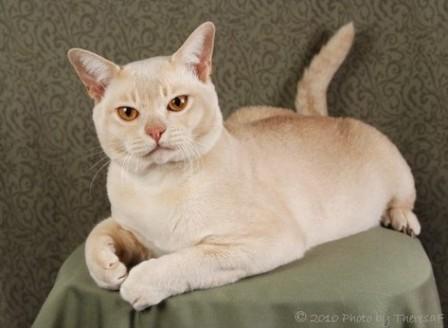
Keeza Energiser Eddey | cream Burmese |owned by Penny Steyn | bred by Pamela Miller | photo © Theresa Fouche
health concerns
Whilst they are generally healthy cats, some breeding lines may suffer from health problems or be more prone to the following conditions:
- Diabetes
- Flat-chested kittens
- Glaucoma
- Hypokalaemic myopathy
- Respiratory problems.
The American type carries a gene responsible for severe craniofacial deformity which is fatal. Kittens generally die at birth.
Cat health insurance should be considered, not just for the Burmese, but for all cats. Please do vaccinate you cat against feline infectious diseases.
diet | average weight of the burmese cat breed
Burmese require no special diet, but saying this, they do need a well blanced diet. Our cat nutrition pages will provide some guidance on cat food options. Clean, fresh water must be provided daily.
The Burmese has an average weight of between 3.5 - 6.5 kg (7.7 - 14.3 lbs)
life expectancy of the burmese cat breed
The Burmese cat has a life span of about 15 years - this is the average age and is
dependent of many factors such as diet, exercise, annual vaccinations
and the general care of your cat.
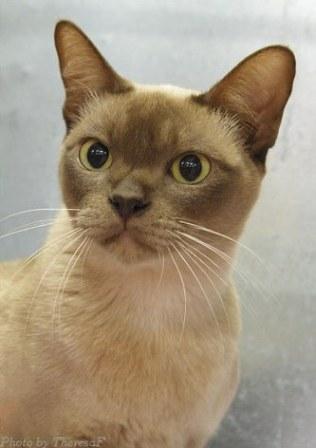
Chocolate Burmese Cat | photo © Theresa Fouche
Related Pages:
Top of Burmese Cat Breed Page
Return to Domestic Cats
search our site
please like us
share our site
recommend on google
rare cats
